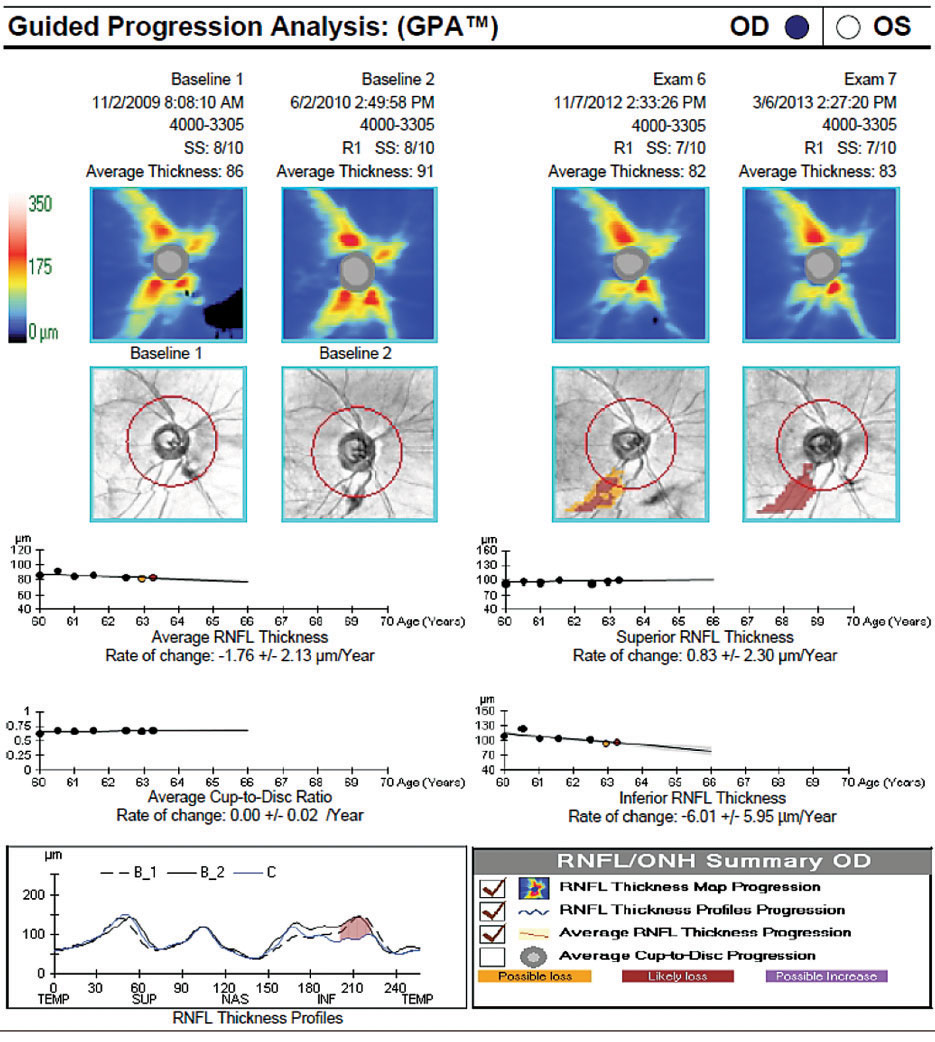 |
When African eyes demonstrate a faster RNFLT thinning than their European counterparts, OCT would allow a sufficient lead time to capture these fast-progressing AD eyes for timely intervention. Photo: Danica J. Marrelli, OD. Click image to enlarge. |
While glaucoma progression is typically evaluated with visual field (VF) testing, OCT is increasingly essential for the assessment of glaucoma and the detection of structural progression. In a new study, researchers examined time to detectable retinal nerve fiber layer thickness (RNFLT) progression by OCT among glaucoma patients of African and European descent and found that time to progression detection was similar for both races when assuming identical RNFLT baseline/thinning rates, and shorter in African eyes under real-world simulation when they had faster RNFLT thinning.
Included were 332 and 542 glaucoma eyes (216 and 317 participants) of Africans and Europeans from with ≥2-years/4-visits of optic nerve head RNFLT measurements after homogenization on age, diagnosis and baseline visual field measurement. Time to trend-based RNFLT progression detection were calculated under standardized scenarios (same RNFLT baseline/thinning rates for both races) and real-world scenarios (African and European cohort-specific RNFLT baseline/thinning rates).
In standardized scenarios, the time to detect RNFLT progression, as well as the percentages of eyes progressing detected within a defined follow-up period, were similar for both races. In real-world scenarios, where African eyes have a faster RNFLT thinning rate (-0.8μm vs. -0.6μm/year) than European eyes, the time to RNFLT progression detection was shorter for African eyes.
“These findings suggest that, in contrast to previous studies of VF progression, the time to detect RNFLT progression was similar in African and European eyes (generally less than three months) when the same thinning rates and baseline RNFLT were assumed, despite the small but statistically significant difference in RNFLT variability,” the authors explained in their article on the work for American Journal of Ophthalmology.
Based on the standardized scenarios results, OCT performed similarly in detecting RNFLT progression in individuals of both races when the same baseline and rates of RNFLT thinning are assumed. “Notably, we performed simulations under different assumed rates of RNFLT thinning (-0.5μm to -2μm/year) and baseline RNFLT (70μm to 90μm),” the authors explained. This is compared to prior studies reporting the mean to range from -0.5μm to -1.5μm/year in glaucoma eyes, regardless of disease severity.
“Moreover, different from prior findings for VF, our findings suggest OCT measured RNFLT may not cause delayed glaucoma progression detection in individuals of African descent, as compared to European descent. This might be explained by the small RNFLT variability of both races, as well as the likely clinically insignificant racial difference between them (~0.1μm),” the authors explained.
The real-world scenarios showed that OCT could detect RNFLT progression earlier in Africans when their thinning rate was faster than that of Europeans, with the lead time ranging from 0.6 to 1.3 years. The larger lead time observed in the sensitivity analysis based on linear regression model was also anticipated, given the mixed-effect modeling tends to result in lower estimated variability, the authors noted.
“Most importantly, with the assumed testing frequency of twice per year, the observed difference in time to detection would allow the clinicians to identify progressing African eyes one to two visits earlier—or even sooner—if more frequent testing is arranged,” the authors explained. “Overall, findings from both scenarios suggest a consistent performance of OCT-measured RNFLT across the two races and its potential to optimize clinical progression detection in fast-progressing African eyes.
This study shows that OCT is likely to perform similarly in eyes of both races.
“Additionally, since OCT examination is efficient, reproducible and less time consuming than VF, it might be suitable for individuals of AD when more frequent or additional testing is desired to detect changes more quickly,” the authors concluded.
Wu JH, Moghimi S, Walker E, et al. Time to glaucoma progression detection by optical coherence tomography in individuals of African and European descents. Amer J Ophthalmol. December 1, 2023. [Epub ahead of print.] |

